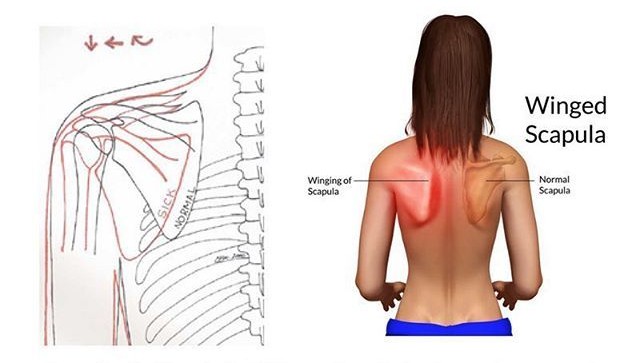Scapular Dyskinesia

Anatomy
The shoulder is a ball and socket joint in the upper extremity. The glenoid (the socket) and the humeral head (ball) form the gleno-humeral joint. This joint is enclosed in a capsule. Surrounding the shoulder are the tendons of four muscles that are responsible for the initiation and modulation of shoulder movement – the rotator cuff. Around these are the larger muscles which are responsible for gross, powerful movements – the trapezius, deltoid, pectorals, rhomboids, latissimus dorsi, levator scapulae. Many of these muscles attach to the shoulder blade (scapula), or the socket part of the shoulder joint. Movement of the shoulder depends on the synchronous action of all these muscles.
Causes
If there is an imbalance within these synergistic muscles, it can affect normal scapula and shoulder function. This imbalance may be due to, among other things, spasm, pathology in another area of the shoulder, overuse and poor technique in sports. A lot of the time it is not quite known what causes the imbalance.
Symptoms
The clinical signs of scapular dyskinesia are shoulder stiffness and pain in certain positions (particularly the middle part of the upper back). There may also be a grinding sound on movement of the shoulder blade (crepitus).
Treatment
The surgeon will take a history and do a detailed clinical examination to see whether you are suffering from scapular dyskinesia. The treatment will revolve heavily around physical therapy, but depending on the exact pathology you may require an injection, and in some rare cases an operation.
- Foot & Ankle
- Hip
- Knee
- Anterior Cruciate Ligament Rupture
- Medial Collateral Ligament Tear
- Meniscus Tears
- Osteoarthritis of the Knee
- Patella (Knee Cap) Dislocation
- Patella Chrondromalacia
- Patella Tendonitis
- Posterior Cruciate Ligament Injury
- Shoulder
- Acromio-clavicular joint pathology
- Biceps tendinopathy
- Frozen Shoulder
- Impingement
- Instability and shoulder dislocation
- Osteoarthritis
- Rheumatoid Arthritis
- Rotator cuff tear
- Scapular Dyskinesia
- Septic Arthritis
- Spine
- Paediatric Orthopaedics
- Abnormal Shape of Legs
- Cerebral Palsy
- Clubfoot
- Developmental Dysplasia of the Hip
- Flat Foot
- Limb Length Difference
- Polydactyly
- Elbow
